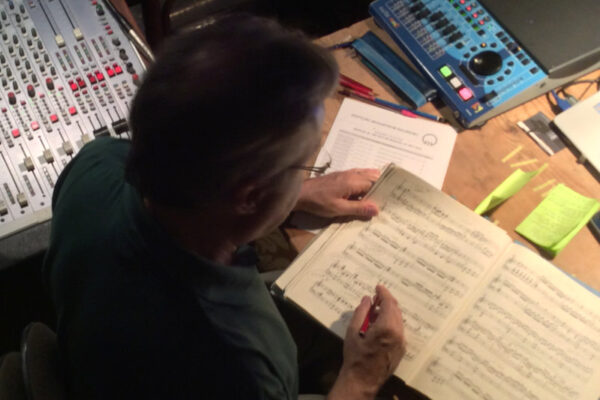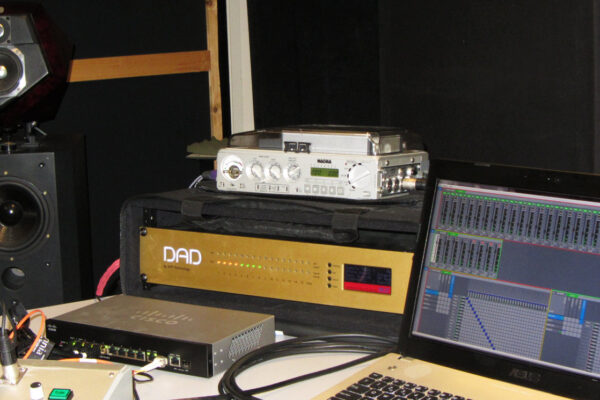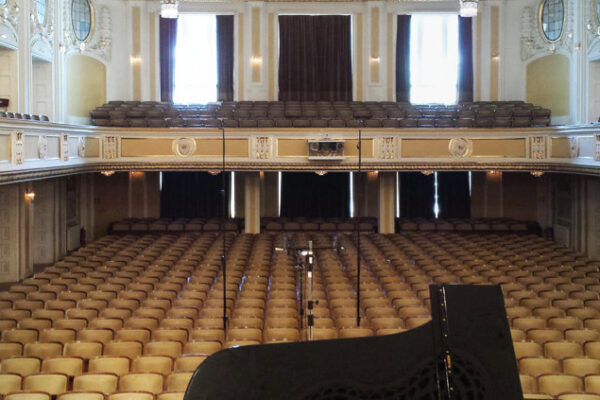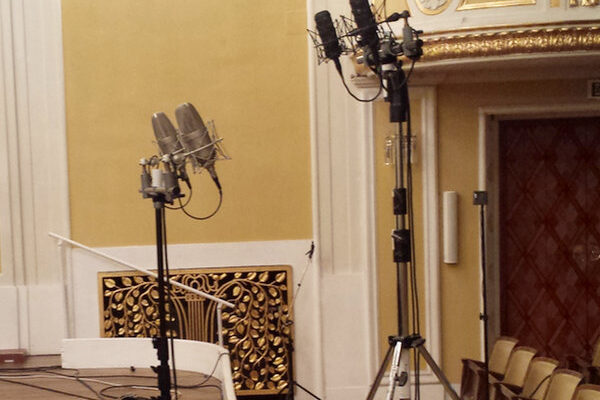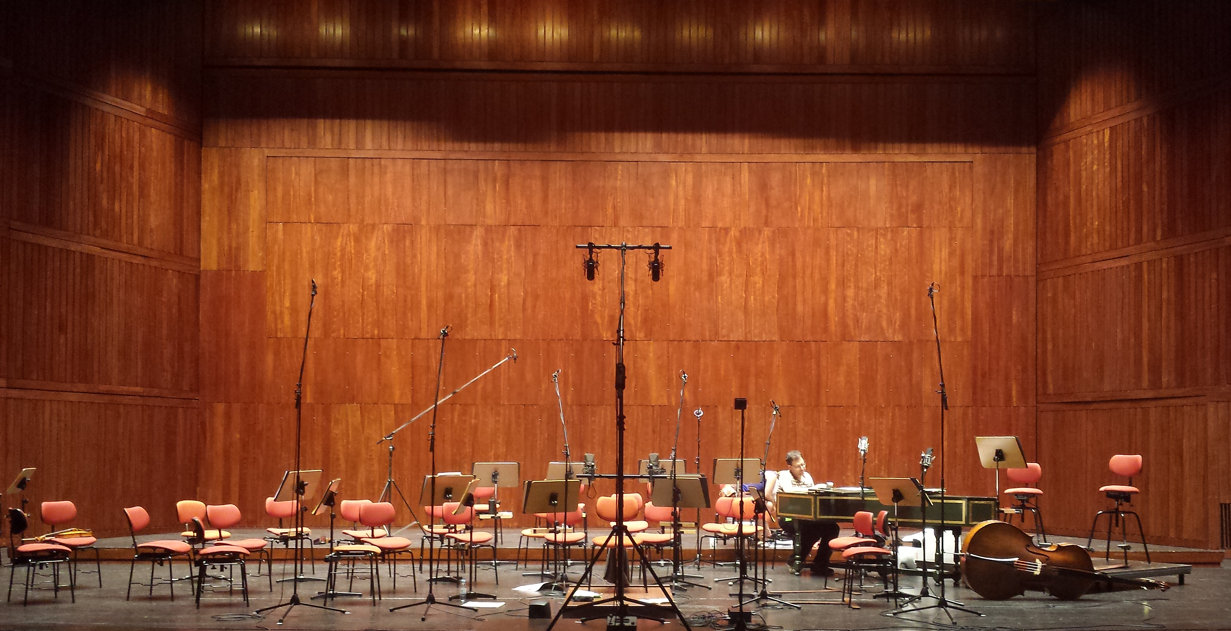
When Recording Is An Art Form in Its Own Right
Being a location recording engineer requires an amazing skillset, but Jean-Martial Golaz takes on a number of roles that reach far beyond placing the microphones and hitting ‘record’.
Often, the role of engineering and producing are separated, but in the case of Swiss location recording engineer, Jean-Martial Golaz, the two roles merge gracefully into a one-man army. Working exclusively in the classical music sphere, the dynamics of the source material are vast and close-miking is rarely found in Jean-Martial’s toolbox.
Further, the acoustics of any given location plays a paramount role, making placement of the microphones critical. Sometimes, it is even required to move the musicians around on the stage to capture the performance perfectly.
As is often the case when it comes to recording acoustic music, the bar for audio transparency and realism is set extremely high. During an impressive career, Jean-Martial has developed ‘golden ears’ and it is second nature for him to pay attention to every single sonic detail, however small they may be.
Recently, Jean-Martial heard of our AX32 audio interface, preamp and AD/DA converter and decided to give it a go. We’re pleased that he liked what he heard and today uses two AX32 units as a permanent part of his recording and mixing/mastering rig. We were fortunate to get the chance to talk to Jean-Martial about gear, music, location recording, audio editing and mastering.
Preparing for Location Recording
Preparations are always important, but unlike engineering the same studio most of the time, location recording is by nature all about traveling with your recording rig and constantly adapt to new stages, venues and room acoustics. We asked Jean-Martial about how he would usually prepare for a recording session.
“Well, normally you have to plan well ahead of the actual session. Apart from the venue in question, you also need to consider the musical pieces you are supposed to record and whether it is a solo performance, chamber, medium ensemble or a full orchestra. Or it could be a choir with lyrics that must be captured in great detail to make every word stand out. In those specific cases, intelligibility is absolutely paramount. And further, remember that location recording is not an exact science, so you can only pre-prepare to a certain degree. Often, once you get there and start setting up your equipment for the initial soundcheck, it all comes down to experience, a gut feeling in terms of the context, as well as ear capacity, listening culture and not least the classical music culture in a broader sense. I usually picture a certain rig beforehand, but more often than not it turns out that I have to make rig changes on the spot.”
The Importance of Microphone Placement
As mentioned, placing the microphones just right is critical, and we wanted to learn more about how Jean-Martial approaches this topic.
“Yes, microphone placement is indeed a crucial factor in classical location recording. I would even go as far as saying that it is the most important criteria for obtaining the best possible result. No matter how much time and effort you put in at the mixing or mastering stages, you can never go back and change the position and placement of the microphones, and you can’t simply use EQs or dynamic tools to solve fundamental issue. So again, balancing microphones during the sound check is extremely important, and it requires a strict methodical approach to do it properly. You need to focus on this main area and be prepared to act very quickly to make adjustments to optimize for critical parameters such as spectral balance, width and depth of the sound image, definition, intelligibility and sound source localization.”
Talking Gear
The gear may ‘just’ be the tools used by the engineer, but as all professionals, Jean-Martial is very much aware of the difference pristine tools can make. If he hears the audio source clearly, defined and highly transparent, he is able to make better calls during the critical microphone placement process, as well as during the actual recording and afterwards at the mixing and mastering stages. Therefore, he aims for the very best in terms of microphones, preamps, converters, mixing board, etc.
“I mainly use Neumann microphones as the main AB pair, and I am especially fond of the TLM 50. Those are really outstanding microphones, even though they can be a bit tricky to use. But every location recording session is unique and sometimes, you need a different flavor so to speak. Therefore, I also have Neumann M149, TLM 170, KM 140, KM143 and U87 sets, as well as Schoeps microphones based on the CMC 6 amplifiers and with the MK2S, MK21 and MK4V capsules.
When it comes to preamps, I added two DAD AX32 units to my recording rig in 2015. One of the units has optional AD cards with preamps onboard, and the results I get from those are amazing.
I was particularly impressed with how natural and ‘true analog’ they sound: Outstanding transparency, impressive dynamics and so much density, but without any harshness in the upper frequencies.
Coming from an analog-audio tradition, I was really scared by the thought of giving up fully analog devices at the preamp stage. Until 2014, I used a great analog console, the Hendicott Series, by E.A.A., a company that is unfortunately no longer around, so I have been used to hear the actual analog sound and not only sampled sound for so many years, but I have to admit that haven’t had any regrets whatsoever. We – my AX32 units and myself – are living very happily together!
For monitoring I rely on large 3-way ICOS Studio active speakers, as well as Neumann KH120 active monitors. I also use Sennheiser HD600 headphones and have been using the SADiE DAW since 1995.”
Getting from Analog to Digital and Back Again
On the surface, digital audio may be a simple concept to grasp. It’s a matter of turning volts in to binary zeroes and ones, right? Correct, but how this is process is conducted will affect the end result immensely. Oh, and then consider that you have to do this twice in opposite orders to go from what the microphones pick up to what the monitors put out… AD/DA conversion matters – and it makes a real difference. Jean-Martial is very much aware of this and elaborates on what he thinks of the conversion the AX32 offers.
“The AX32 with the preamps installed is sitting on the stage during recording, and obviously it is here the critical A/D conversion happens. The second AX32 unit is by my side during recording as well as for post-production work, and it handles all D/A conversion. During recordings, I can actually enjoy the full circle of DAD AD/DA conversion in real-time – and I just love it. In fact, I have noticed that since I started recording with the AX32 units, the mixing and mastering stages also benefit hugely as I can now apply EQ changes without any digital artifacts. To me, that is sheer proof that the AX32 has extremely low distortion, as well as a wonderfully transparent sonic footprint.
And one final point about the D/A stage on the AX32 – I love the fact that I can plug in my headphones directly to the output of the second unit during recording, as well as during mastering, and know that I am listening to the ‘actual’ sound of my recordings – completely uncolored by any unnecessary, external amplifying devices.”
Beyond Engineering
For Jean-Martial a recording session is not a single-ended task. He does not ‘just’ record and then hand over the source material for others to mix and master. But still, that is not the full story about his stake in producing great-sounding classical albums.
Partly, due to the fact that he may physically move some of the musicians around, he affects the artistic output. Therefore, Jean-Martial needs to have a deep knowledge of the music being recorded and since part of his job is artistic supervision, he always has to reads along in the sheet music. Quite simply, he needs to be able to give the artists feedback, discuss artistic matters and take notes with regard to editing work at the post-production stage.
“I am usually responsible for the entire production, which includes not only recording, but also artistic supervision, editing, mixing, mastering. You really need to be aware of every eventuality and cover the full scope of the production.
Especially in the case of a live recording in front of an audience, this can be very challenging. For instance, the soundcheck and setup has been conducted in an empty concert hall, and as we all know, once you fill up a concert hall with people, room acoustics are drastically affected. The challenge here is to make recordings captured in an empty hall co-exist with recordings from a hall with audience. During the live, audience takes, a bit of on-the-fly mixing may be required, but especially afterwards when it all has to be combined, there is often some rather complex mixing work to be done.
For instance, one of my biggest challenges was the recoding of J.S. Bach’s Matthäus Passion, which I did back in 1999 with Philippe Herrewehge and the Collegium Vocale Gent ensemble. This huge masterpiece lasts for almost 3 hours, and along the way, the instrumentation settings change continuously – from a single voice over multiple voices to full orchestra or even double orchestra and double choir. And all of this had to go directly to a stereo track, summing the signals of 20 microphones and mixing on the spot. That was just crazy!”
The Stradivarius and the Virtuous
In late 2015, jean-Martial set out to capture a quite special performance. The event had many dimensions and each of them contributed to the uniqueness of this particular recording.
“I was fortunate to get the chance to capture the amazing ‘Chevillard, King of Portugal’ Stradivarius cello from 1725, played by virtuous cellist, Pavel Gomziakov, performing Joseph Hayden’s Cello Concertos and Adagios along with The Gulbenkian Orchestra. This amazing instrument was generously lent to the project by The National Museum of Portugal, and I am very pleased with the result. The sound has a certain color, and I think that you can really hear the transparency and ‘analog sound’ of the AX32 in there.”
Formats, Protocols and the Future
The world of audio has been evolving for centuries. From rudimentary recordings direct to wax over lacquer and vinyl to tape, discs and hard drives. And beyond the sheer recording mediums, a vast amount of underlying technologies, standards and best practices have been evolving in similar ways. We asked Jean-Martial about his view on this development as it is today as well as how he imagines future developments within this field.
“In my corner of the professional audio world, resolution is a key factor. In general, many seem to have settled for 44.1 or 48 kHz in production and even accepted distribution in various compressed audio formats such as AAC or mp3, but in the classical sphere, 96 kHz is fairly common. I have recorded at 96 kHz ever since 1998 and on a few occasions even at 192 kHz. In general, I think the standardization of high definition recording is a good direction, and I hope that we can even move beyond 96 kHz as the common standard one day.
Another interesting development is audio over IP, and in that regard, I should mention that I use the Audinate Dante protocol to connect my two AX32 devices. While I must admit that setting up the audio network initially was not the easiest task I have ever thrown myself at, once it was set up and stored, it does work seamlessly and for transporting digital data and connecting digital devices, I think this is going to play an increasingly important role in pro audio. And as an additional note, I would like to stress that I have found the protocol to handle digital clock very well without any jitter.”
Golden Tips by the Golden Ears
Having a location recording capacity like Jean-Martial at our disposal, not asking him to share some tips based on his excessive experience and spades of talent would be a missed opportunity. So we did ask him!
“In general, to me the most important factor is to prepare properly for the job in advance. If possible go to the venue and get familiar with the room a day or two before the recording session. Also, gain as much knowledge and not least understanding of the piece you are to record, and perhaps above it all, love your job!
I have no ‘secret recipe’ for placing the microphones just right. I work with my ears and listen in front of the musicians as they perform. Based on that, I choose a certain distance and height as the starting point. In case, it is not a live performance with an audience, and if the ensemble is not too big, you can sometimes solve issues by asking one or more of the musicians to move slightly left, right, forward or backwards. And remember that there is more to microphone placement than just identifying an ideal location on the floor and a certain height. You also need to carefully prepare the main AB pair, taking the distance between the capsules and the relative angle between them into careful consideration.
As for more concrete tips, I would like to emphasize 5 specific points.
1) When working on getting the mic balance perfect, develop a methodical approach and stick with it at all times. Consider marking the initial microphone placements on the floor as well as the mic height, as this is essential to truly understand the process – and the progression – of the balancing work. You need to be able to come back to square one so to speak.
2) The second point is somewhat related to the first. Once you have a good starting point, only change one thing at a time in your pursuit to obtain perfection. For instance, it could be tempting to make slight adjustments to the distance, mic height and incidence at the same time. If you are experienced, you probably have a pretty good idea about how each adjustment affects the sound. But in reality, it is very hard to determine exactly how each of the three parameters you just adjusted actually affect the total sonic outcome and it is far to easy to get lost. Therefore, only adjust one parameter at a time. Then listen closely to how this one thing affects your sound. If you like it, leave it there and move on to the next parameter. If you don’t like what you hear, move back to the first position and try adjusting something else. In short, keep it methodic and remain disciplined throughout the process.
3) Always try to limit the number of mics, and do the initial balance work only using the main AB pair. Even if you have set up a number of spot mics, focus on balancing the AB pair just right, and more often than not, you will find that some of the spot mics are actually unnecessary and may be removed entirely.
4) If the room acoustics are great, and only in this case, remember to set up ambience microphones to capture the natural tone an vibe of the location. Also don’t be afraid to experiment with setting the room mics up facing back or front in order to capture the acoustics character of the venue.
5) Finally, and most importantly, remember that you are working with other people on a common goal. You may be the one-man tech army, but you’re dealing with artists, so never underestimate the importance of the various psychological mechanisms going on when a musician performs his or her art form in a context that is supposed to be kept for generations to come. Establishing mutual trust is absolutely paramount.”
Well, there is no doubt that Jean-Martial is far more than the techy guy, connecting cables, pushing buttons and dialing knobs. He is a central part of the projects he take part in, and he cares as much for the music as for the sheer fidelity of the sound. Obviously, when both factors meet in beautiful synergy and magic moments emerge, it hardly gets any better. And when these rare moments occur, we’re proud to have the AX32 sitting comfortably at the beginning as well as the end of the signal chain, ensuring that these moments are preserved to their fullest extent.

